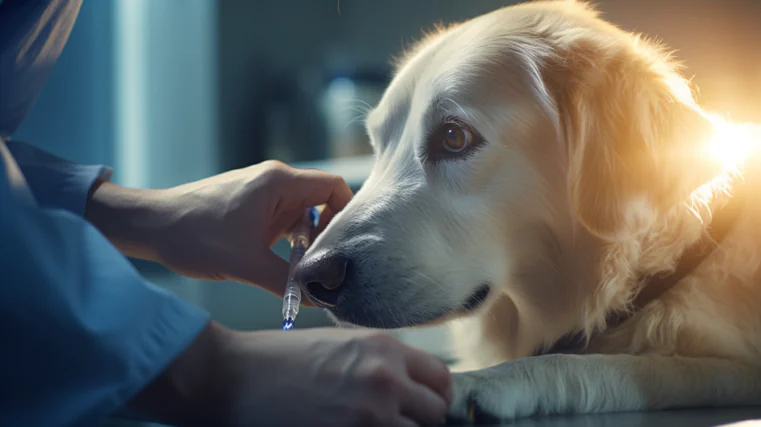Table of Contents
Imagine your dog’s body is a well-oiled machine, with insulin as the crucial fuel that keeps everything running smoothly; timing matters just like with any device. In the intricate world of managing diabetes in dogs, giving insulin early can be a risky move that could lead to unforeseen consequences.
This article explores the risks and rewards of “can i give my dog insulin 2 hours early”, shedding light on the importance of consistency and the potential benefits of getting it right. You’ll discover the impact that timing has on your furry friend’s quality of life and its role in their overall well-being.
From understanding the science behind insulin to the potential consequences of delayed administration, this evidence-based guide will empower you to make informed decisions. So, join us as we delve into the fascinating world of timing and learn how it can be a game-changer for your dog’s health.
Key Takeaways Of “Can I Give My Dog Insulin 2 Hours Early”
- The timing of insulin administration is crucial in managing diabetes in dogs.
- Inconsistent insulin administration can lead to complications such as hyperglycemia or hypoglycemia.
- Proper timing of insulin administration prevents diabetic complications such as ketoacidosis, neuropathy, and kidney damage.
- Timely insulin administration reduces the risk of hyperglycemia or hypoglycemia symptoms.
Understanding Insulin and its Role in Managing Diabetes in Dogs

Insulin is a hormone that regulates blood sugar levels in the body. It is commonly used to treat diabetes in dogs. Insulin injections are typically given once or twice a day, depending on the dog’s specific needs and the type of insulin used.
Sticking to a consistent daily routine when administering insulin to your dog is important. This involves giving the insulin by injection around the same time each day, ideally 12 hours apart for twice-daily injections.
If you accidentally give your dog insulin 2 hours early, it shouldn’t cause any major issues. However, consistently providing injections of insulin too early or late can disrupt blood sugar control and potentially lead to complications.
On the other hand, missing an insulin shot can have more significant consequences. When a dose of insulin is missed, blood sugar levels can spike, leading to hyperglycemia. This can cause symptoms such as excessive thirst, increased urination, weight loss, and even more severe complications if left unaddressed.
If you ever miss giving your dog its insulin shot, it is important to consult your veterinarian for guidance on what to do next. They may recommend adjusting the dose or implementing alternative treatment measures to effectively manage your dog’s blood sugar levels.
Moving forward, let’s discuss the importance of consistency in insulin administration.
The Importance of Consistency in Insulin Administration
Consistency in administering insulin is crucial, but what happens if you miss a dose? Consistency benefits your dog’s health by maintaining stable blood sugar levels, essential in managing diabetes. Time management plays a vital role in ensuring timely insulin administration. It’s important to administer insulin simultaneously every day to maintain consistency.
Establishing a routine can help you remember and prioritize your dog’s insulin needs. Inconsistent insulin administration can lead to fluctuations in blood sugar levels, causing complications such as hyperglycemia or hypoglycemia. These fluctuations can have serious consequences for your dog’s health and well-being.
Therefore, it’s crucial to maintain consistency in insulin administration to keep your dog’s blood sugar levels stable and minimize the potential risks of giving insulin early.
Potential Risks of Giving Insulin Early

Administering insulin before the designated time can disrupt your dog’s blood sugar levels and potentially jeopardize their health. It’s crucial to understand the risks involved in giving a bottle of insulin early to ensure the well-being of your furry friend. Here are the potential dangers:
- Hypoglycemia: Giving insulin early can cause a sudden drop in blood sugar levels, leading to weakness, confusion, tremors, and even seizures.
- Hyperglycemia: On the contrary, giving insulin too early might not adequately regulate your dog’s blood sugar, resulting in increased thirst, frequent urination, and a lack of energy.
- Inconsistent insulin absorption: Giving insulin earlier than prescribed can disrupt the consistent absorption of the hormone, making it less effective in controlling blood sugar levels.
- Treatment failure: Incorrect timing can render the insulin treatment ineffective, putting your dog at risk of developing complications associated with diabetes.
- Altered insulin requirements: Administering insulin early can confuse your dog’s body and alter its insulin requirements, making it difficult to regulate its blood sugar properly.
Understanding these risks highlights the importance of giving insulin at the right time. By doing so, you can ensure your dog’s health and prevent potential complications associated with diabetes.
Benefits of Giving Insulin at the Right Time
Giving insulin to your dog a couple of hours early may have some benefits. When administering insulin earlier than the usual dose, the hormone starts working before blood sugar levels spike. This can help control your dog’s glucose levels throughout the day.
Giving insulin earlier can prevent hyperglycemia, leading to symptoms like excessive thirst, increased urination, and weight loss. Consistency is still important, but adjusting the timing slightly can benefit your pet’s overall health.
However, it is essential to consult your veterinarian before changing your dog’s insulin regimen. They will guide you on the appropriate dosage and timing for your dog’s needs. Monitoring your dog’s response to the adjusted timing is crucial to ensure it effectively controls its diabetes.
Remember, maintaining a consistent daily routine is generally the best approach for insulin administration. But if you accidentally give the insulin slightly early, it is unlikely to cause any major issues. Always consult your vet for personalized guidance on your dog’s insulin therapy.
Consulting with Your Veterinarian

Before consulting your veterinarian, consider the risks and rewards of giving your dog insulin early. Consulting with your veterinarian can provide various benefits when managing your dog’s diabetes. They have the expertise and knowledge to guide you through the process and ensure you make the best decisions for your furry friend.
During the consultation, your veterinarian will discuss the potential risks and rewards of administering insulin early. They’ll also provide you with communication strategies to monitor your dog’s response to insulin effectively. By working closely with your veterinarian, you can establish a comprehensive plan that considers your dog’s individual needs and helps minimize the risks associated with early insulin administration.
This will set the stage for effectively monitoring your dog’s response to insulin and ensuring their health and well-being.
Monitoring Your Dog’s Response to Insulin
See if your pup’s response to insulin is positive by keeping a watchful eye on their blood sugar levels. Monitoring techniques like regular blood glucose testing can help you determine if the insulin dosage is appropriate for your dog. By measuring blood sugar levels at specific times throughout the day, you can identify patterns and adjust the insulin dosage accordingly.
It’s important to consult with your veterinarian to establish your dog’s target blood sugar range and to understand the specific recommended monitoring techniques. Regular monitoring will allow you to assess how well your dog’s body responds to the insulin and whether any adjustments need to be made. By closely monitoring your dog’s response to insulin, you can ensure optimal management of their diabetes.
Transitioning into the subsequent section, factors such as meal times and activity levels should also be considered when determining the best time for insulin administration.
Factors to Consider When Determining the Best Time for Insulin Administration
When giving your dog insulin, following the proper treatment guidelines and consulting with your veterinarian is important. However, if you are wondering whether you can give your dog insulin 2 hours early, there are several factors to consider.
Firstly, the type of insulin used and the routine established for your dog’s daily insulin injections play a crucial role. Dogs with diabetes mellitus require regular time intervals between doses of insulin to maintain a consistent blood glucose level. Deviating from this normal routine can disrupt the blood glucose curve and lead to ineffective insulin management.
Additionally, the insulin concentration and the dose of insulin prescribed by your veterinarian are important factors to consider. Giving an insulin overdose or an extra dose can result in severe hypoglycemia, which can be a life-threatening emergency for your dog. It is always best to adhere to the prescribed amount of insulin and not make any adjustments without consulting your veterinarian.
Moreover, the glucose level in your dog’s body and body weight can impact the timing of insulin administration. Blood glucose readings and urine testing are essential in monitoring your dog’s response to insulin and determining the appropriate timing for administration. If your dog has a urinary tract infection or bladder infection, it may affect their water intake and urine testing results, further complicating insulin management.
Another factor to consider is the type of food your dog consumes. Regular food intake and reduction in food intake can affect glucose absorption and insulin effectiveness. It is important to maintain a consistent diet and feed your dog at the same time each day to ensure proper management of diabetes mellitus.
Regarding insulin administration, it is crucial to use the insulin bottle correctly and administer it by injection. Insulin pens can provide a convenient and accurate way to distribute insulin. Proper storage of insulin in an airtight bottle is necessary to maintain its effectiveness.
Giving your dog insulin 2 hours early can disrupt the blood glucose curve and lead to ineffective insulin management. Sticking to the routine established by your veterinarian and consulting with them before making any changes is best. Proper management of diabetes mellitus in dogs requires consistent administration of the prescribed dose of insulin, monitoring of blood glucose curves, and regular veterinary check-ups to ensure the well-being of your furry friend.
Your Dog’s Activity Level and Meal Schedule
Feeding your dog consistently and keeping them active throughout the day can greatly impact their insulin needs. Meal preparation and insulin dosage adjustment are crucial in managing your dog’s diabetes. By understanding your dog’s activity level and meal schedule, you can effectively determine the best time for insulin administration. An organized routine allows for better predictability in their insulin requirements. To illustrate this concept, consider the following table:
| Activity Level | Meal Schedule | Insulin Needs |
|---|---|---|
| Low | Consistent | Stable |
| High | Inconsistent | Fluctuating |
| Moderate | Varied | Adjusted |
| Low | Varied | Adjusted |
| High | Consistent | Stable |
As you can see, a dog with a high activity level and inconsistent meal schedule may have fluctuating insulin needs. Conversely, a dog with low activity and a consistent meal schedule may have stable insulin needs. Understanding these patterns can help you make informed decisions about insulin timing. Moving forward, it is important to consider the type of insulin being used.
Tips for Administering Insulin to Your Dog

If you’re struggling with administering insulin to your dog, don’t worry – many pet owners have faced the same challenge and found solutions that work for them. Here are some tips for handling insulin injections and strategies for reducing stress during insulin administration.
First, ensure you have all the necessary supplies, such as insulin syringes and sharps containers.
Create a calm and quiet environment for your dog by finding a comfortable spot and minimizing distractions.
Before administering the injection, gently massage the injection site to increase blood flow and help with absorption.
Hold the syringe at a 45-degree angle and insert the needle quickly and smoothly when injecting.
Afterward, reward your dog with a treat or praise to create positive associations.
These tips can help make the process easier and more comfortable for both you and your furry friend.
As we move into the next section about the role of diet and exercise in insulin management…
The Role of Diet and Exercise in Insulin Management

When managing insulin in your dog, it’s crucial to consider the role of diet and exercise. Choosing the right diet for diabetic dogs is essential to maintain stable blood sugar levels and manage their condition effectively.
Regular exercise in your dog’s routine can also help regulate blood sugar levels and improve insulin sensitivity.
Choosing the Right Diet for Diabetic Dogs
Opt for a diet specifically tailored for diabetic dogs to properly manage their condition. When it comes to diabetic dog food options, there are several choices available that can help regulate your dog’s blood sugar levels. These options include commercial diabetic dog food, homemade diets, and even prescription diets recommended by your veterinarian. It is crucial to follow feeding guidelines for diabetic dogs, which typically involve consistent meal times and portion control. Additionally, these diets often have a specific balance of carbohydrates, proteins, and fats to help stabilize blood glucose levels.
To help you understand the importance of choosing the right diet for your diabetic dog, here is a table summarizing the three main diabetic dog food options:
| Diabetic Dog Food Options | Description |
|---|---|
| Commercial Diabetic Dog Food | Specially formulated to meet the nutritional needs of diabetic dogs. |
| Homemade Diets | Allows for more control over ingredients, but requires careful planning and monitoring. |
| Prescription Diets | Recommended by veterinarians for dogs with specific dietary needs. |
By incorporating the appropriate diet for your diabetic dog, you can effectively manage their condition. Now, let’s transition into the subsequent section about incorporating regular exercise into your dog’s routine.
Incorporating Regular Exercise into Your Dog’s Routine
To keep your furry friend’s health in tip-top shape, it’s time to hit the pavement and make exercise a paw-some part of their daily routine, giving their body a chance to soar like a joyful kite in the wind. Incorporating exercise into your dog’s routine is crucial for managing their blood sugar levels.
Regular physical activity helps to increase insulin sensitivity, allowing the body to utilize glucose more effectively. It also promotes weight management, which is essential for diabetic dogs. Exercise helps to control blood sugar levels by stimulating glucose uptake by muscles, reducing the need for insulin.
However, it’s important to consult your veterinarian to determine the appropriate level and duration of exercise for your dog. Too much or too little exercise can adversely affect their blood sugar levels.
Now, let’s explore the potential consequences of delayed insulin administration.
Potential Consequences of Delayed Insulin Administration

When you delay administering insulin to your dog, you risk causing hyperglycemia, which is characterized by high blood sugar levels. Hyperglycemia can negatively affect your dog’s health, including increased thirst and urination, weight loss, and fatigue.
Additionally, long-term complications can arise from poor blood sugar control, such as damage to the kidneys, eyes, and nerves. Understanding the potential consequences of delayed insulin administration is crucial to effectively manage your dog’s insulin levels and prevent these complications.
Hyperglycemia and its Effects
Although it may seem counterintuitive, ignoring the signs of hyperglycemia in your dog can have serious consequences. Hyperglycemia refers to high blood sugar levels, which can occur when insulin isn’t administered in a timely manner. Managing hyperglycemia is crucial for maintaining insulin effectiveness and preventing long-term complications.
When blood sugar levels are elevated, your dog may exhibit symptoms such as increased thirst, frequent urination, and weight loss. Additionally, hyperglycemia can lead to dehydration, ketoacidosis, and even diabetic coma if it’s left untreated. Addressing hyperglycemia promptly and administering insulin as prescribed can help regulate your dog’s blood sugar levels and reduce the risk of these complications.
Moving forward, it’s important to consider the long-term complications of poor blood sugar control.
Long-term Complications of Poor Blood Sugar Control
Neglecting proper blood sugar control can result in serious long-term complications for your furry companion. Consistently high blood sugar levels, also known as hyperglycemia, can lead to various health issues that can significantly impact your dog’s quality of life. The table below highlights potential long-term complications associated with poor blood sugar control in dogs.
| Complication | Description | Impact |
|---|---|---|
| Diabetic neuropathy | Nerve damage leading to weakness and loss of coordination | Difficulty walking and potential paralysis |
| Cataracts | Clouding of the lens in the eye | Vision impairment and potential blindness |
| Kidney disease | Impaired kidney function and potential kidney failure | Increased thirst, frequent urination, and lethargy |
These complications emphasize the importance of timely and accurate insulin administration. Maintaining proper blood sugar control can significantly reduce the risk of these long-term complications and improve your dog’s overall quality of life. Transitioning into the subsequent section, it is crucial to understand the impact of timing on your dog’s quality of life.
The Impact of Timing on Your Dog’s Quality of Life

Timing is an important aspect of insulin administration for dogs with diabetes, but is it safe to give insulin to your dog 2 hours early? While it may help prevent hyperglycemia and its associated symptoms, it is crucial to consult your veterinarian before making any changes to your dog’s insulin regimen.
Adjusting the timing of insulin injections can prevent high blood sugar episodes, leading to excessive thirst, increased urination, and weight loss. However, it is essential to maintain consistency and stay within your dog’s regular insulin schedule.
Your veterinarian is the best person to guide you on the appropriate timing and dosage of insulin specific to your dog’s needs. They will consider factors such as your dog’s blood glucose levels, insulin requirements, and overall health.
Regular monitoring of your dog’s response to the adjusted timing is crucial. This helps determine the new schedule’s effectiveness in controlling their diabetes. Keeping track of your dog’s blood sugar levels, weight, and any changes in their behavior is important in ensuring proper diabetes management.
| Timing | Risks | Rewards |
|---|---|---|
| Early | Hypoglycemia | Stable blood sugar levels |
| Late | Hyperglycemia | Preventing complications |
| Optimal | Stable blood sugar levels | Improved quality of life |
Understanding the timing challenges and incorporating a consistent schedule can significantly improve your dog’s quality of life. Finding the right timing for insulin administration is essential to ensure your furry friend’s well-being.
Frequently Asked Questions
Can giving insulin to my dog too early have any negative effects?
Giving insulin to your dog too early can have negative effects. Timing considerations are crucial to avoid insulin administration risks such as hypoglycemia or hyperglycemia. It is essential to follow your veterinarian’s instructions for the proper timing of insulin administration.
How long does it take for insulin to start working in dogs?
Insulin effectiveness in dogs can vary, but it usually starts working within 15-30 minutes after injection. However, insulin absorption may be influenced by factors like exercise and food intake, so monitoring your dog’s response to treatment is important.
Are there any specific factors that can affect the timing of insulin administration in dogs?
Factors affecting insulin timing in dogs include the types of insulin used, meal timing, exercise, and individual response. Best practices for insulin administration involve consistent timing, monitoring glucose levels, and adjusting dosage based on veterinary guidance and regular check-ups.
What are the potential consequences of administering insulin late to my dog?
Administering insulin late to your dog can lead to potential risks, such as uncontrolled blood sugar levels, diabetic ketoacidosis, and long-term complications. Delayed insulin administration can disrupt your dog’s health and overall well-being.
How can I monitor my dog’s response to insulin to ensure it is being administered at the right periods of time?
To monitor your dog’s response to insulin and ensure it’s administered at the right time, use monitoring techniques like blood glucose testing and observing signs of hypoglycemia such as weakness, trembling, and disorientation.
Conclusion
In conclusion, it is important to follow the recommended guidelines and instructions your veterinarian provides when administering insulin to your dog. Giving insulin doses too early or too late can significantly affect your dog’s blood glucose levels and overall health. It is crucial to maintain a regular routine and consistent administration of insulin to ensure proper management of diabetes mellitus in dogs. The timing of insulin injections should be based on the insulin type used, the peak insulin and glucose levels, and your dog’s specific needs.
Monitoring your dog’s blood samples, urine testing, and regular veterinary check-ups are essential for assessing the effectiveness of insulin treatment and making any necessary adjustments. It is also important to consider factors such as your dog’s body weight, water intake, food type and intake, exercise levels, and other medical conditions, such as urinary tract infections or thyroid hormone imbalances, that may impact insulin absorption and glucose levels. In case of any concerns or emergencies, always consult your veterinarian or seek immediate veterinary care, as severe hypoglycemia or insulin overdose can be life-threatening. Proper management of diabetes mellitus in dogs requires consistent and careful attention, and with the right treatment and monitoring, your dog can lead a happy and healthy life.
Reader Advisory: This article, aimed at informational purposes, does not replace professional veterinary advice. While we aim for accuracy, we make no guarantees regarding the completeness or reliability of our content. Always consult a veterinarian before altering your dog’s diet or nutrition.




